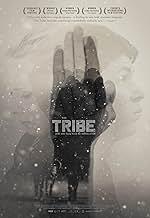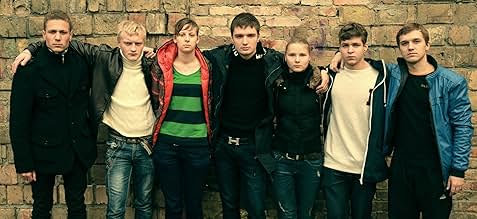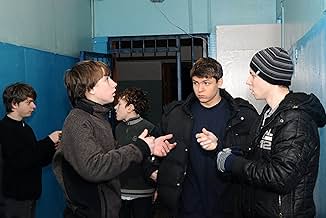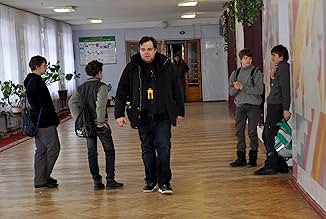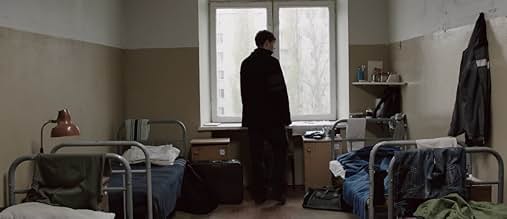NOTE IMDb
7,0/10
12 k
MA NOTE
Un garçon sourd rejoint un internat pour enfants similaires. Confronté aux singeries violentes et criminelles de certains autres garçons et filles, il lutte pour se conformer et rejoindre la... Tout lireUn garçon sourd rejoint un internat pour enfants similaires. Confronté aux singeries violentes et criminelles de certains autres garçons et filles, il lutte pour se conformer et rejoindre la « tribu ».Un garçon sourd rejoint un internat pour enfants similaires. Confronté aux singeries violentes et criminelles de certains autres garçons et filles, il lutte pour se conformer et rejoindre la « tribu ».
- Réalisation
- Scénario
- Casting principal
- Récompenses
- 30 victoires et 25 nominations au total
Hryhoriy Fesenko
- Sergei
- (as Grigoriy Fesenko)
Oleksandr Dsiadevych
- Gera
- (as Alexander Dsiadevich)
Oleksandr Osadchyi
- King
- (as Alexander Osadchiy)
Oleksandr Sydelnykov
- Shnyr
- (as Alexander Sidelnikov)
Oleksandr Panivan
- Woodwork Teacher
- (as Alexander Panivan)
Kyrylo Koshek
- Sponsor
- (as Kyril Koshyk)
Avis à la une
The Tribe hit my radar a while back when I heard about the novelty of a film being silent in the world of the hearing impaired in a foreign country w/no subtitles in existence. What is essentially a silent film made in the digital age, eschews themes we've seen in other cinematic rites of passage w/silent thieves on the make all the time going from one score to the next. One wonders if the bleakness depicted translates to other schools of impairment around the world where the easy way out of dealing w/adversity is to turn to a life of crime. The choice of an non-subtitled version really puts the onus on our viewing collective who don't have the patience for this interesting endeavor.
I had read about this film and wanted to see it, so I was happy to find it streaming on Netflix. The story takes place at a Ukrainian school for the deaf, and what I didn't realize until watching was that aside from a few mumbles, gasps, and background chatter, the characters speak only in Ukrainian sign language, without the use of subtitles, translations, or narration. There's not even any music, for crying out loud (although we do hear all the other sounds of the world though, doors closing and footsteps and things, the absence of which I think would have felt pretty strange).
But honestly, none of that bothered me. Not having to read subtitles let me enjoy the film in a different way. Even if you understand sign language, I didn't feel like the filmmakers went out of their way to focus on the signing. Often it took place in the distance, or the character's back would be turned or at a funny angel. There are a few scenes where it's hard to tell what they're talking about, but overall I never felt like I was missing much. The relative silence added to the experience, and I even found myself at time subconsciously thinking that I was unable to hear, kinda like when I watched The Invention of Lying on an airplane and thought that I too, like the characters in that film, was unable to tell a lie. But that was the only good thing about that movie, if you can even call it a good thing.
So, back to The Tribe. Unless you understand Ukrainian sign language, the characters' exact word choice is anyone's best guess, but the story is simple enough and told in such a way that it's easy enough to follow based on context, body language, and the things we see happening. I think it is anyway, unless I got the story totally wrong! But hey, it made enough sense to me! I may have been confused at times, but always felt like I was meant to be, like that was part of the story and the filmmakers' intention.
But the acting didn't quite cut it. I don't think any of these were professional actors, since their main requirement would have been fluency in sign language, and it really showed, despite there being no spoken dialog. They walk strangely and unnaturally, as if uncomfortable on camera, and too often stare off awkwardly in order to avoid looking at the camera. In one scene, three of the main character push their way through a crowd, but the exrtas in the scene all but ignore the annoyance, staring awkwardly straight ahead or at the ground. And one fight scene toward the start of the film almost ruined it for me. It was too clearly choreographed and looked as though the characters were dancing. Fortunately, the best bit of acting comes from our lead character, who was well-cast with his perpetually blank expression.
There are a few pretty explicit sex scenes, which didn't bother me except for the fact that, in the filmmakers' attempt to show as much as possible, it becomes pretty obvious that the sex is simulated, and the scenes are unconvincing and ineffective.
I'm typically a fan of European film with long takes, such as the ones in this film, but too often here we see doors being left open for the cameraman to enter when they would normally be closed in real life. Sometimes it's excusable, but at one point a character who is being chased on foot stops to hold the door open for the cameraman behind him. Another time, an apartment door is left open to the world while illegal activity is conducted just inside, and multiple doors throughout the film are left open to the cold outside.
This movie wasn't terrible, but the flaws, which were sometimes laughable, were too numerous to ignore. But there were a few things I loved about this film. I very much enjoyed the camera-work in general: long takes following the characters through various environments, down hills and through trees, jumping between characters. One particular scene shows separate actions occurring simultaneously in two different rooms, both visible in the same shot from the outside through adjacent windows. It was well-done and clever, but never felt gimmicky. I love stuff like that.
And I'm glad that, despite the terrible fight scene I was forced to endure, I still gave this movie a chance and stuck around to the end, because the last scene is very very good. It's one of the best endings I can remember seeing in a while. It's very effective, well-acted, well-shot, and all around well done from a technical standpoint.
Overall, I didn't love The Tribe, but I recommend it for for the ending, if for no other reason.
But honestly, none of that bothered me. Not having to read subtitles let me enjoy the film in a different way. Even if you understand sign language, I didn't feel like the filmmakers went out of their way to focus on the signing. Often it took place in the distance, or the character's back would be turned or at a funny angel. There are a few scenes where it's hard to tell what they're talking about, but overall I never felt like I was missing much. The relative silence added to the experience, and I even found myself at time subconsciously thinking that I was unable to hear, kinda like when I watched The Invention of Lying on an airplane and thought that I too, like the characters in that film, was unable to tell a lie. But that was the only good thing about that movie, if you can even call it a good thing.
So, back to The Tribe. Unless you understand Ukrainian sign language, the characters' exact word choice is anyone's best guess, but the story is simple enough and told in such a way that it's easy enough to follow based on context, body language, and the things we see happening. I think it is anyway, unless I got the story totally wrong! But hey, it made enough sense to me! I may have been confused at times, but always felt like I was meant to be, like that was part of the story and the filmmakers' intention.
But the acting didn't quite cut it. I don't think any of these were professional actors, since their main requirement would have been fluency in sign language, and it really showed, despite there being no spoken dialog. They walk strangely and unnaturally, as if uncomfortable on camera, and too often stare off awkwardly in order to avoid looking at the camera. In one scene, three of the main character push their way through a crowd, but the exrtas in the scene all but ignore the annoyance, staring awkwardly straight ahead or at the ground. And one fight scene toward the start of the film almost ruined it for me. It was too clearly choreographed and looked as though the characters were dancing. Fortunately, the best bit of acting comes from our lead character, who was well-cast with his perpetually blank expression.
There are a few pretty explicit sex scenes, which didn't bother me except for the fact that, in the filmmakers' attempt to show as much as possible, it becomes pretty obvious that the sex is simulated, and the scenes are unconvincing and ineffective.
I'm typically a fan of European film with long takes, such as the ones in this film, but too often here we see doors being left open for the cameraman to enter when they would normally be closed in real life. Sometimes it's excusable, but at one point a character who is being chased on foot stops to hold the door open for the cameraman behind him. Another time, an apartment door is left open to the world while illegal activity is conducted just inside, and multiple doors throughout the film are left open to the cold outside.
This movie wasn't terrible, but the flaws, which were sometimes laughable, were too numerous to ignore. But there were a few things I loved about this film. I very much enjoyed the camera-work in general: long takes following the characters through various environments, down hills and through trees, jumping between characters. One particular scene shows separate actions occurring simultaneously in two different rooms, both visible in the same shot from the outside through adjacent windows. It was well-done and clever, but never felt gimmicky. I love stuff like that.
And I'm glad that, despite the terrible fight scene I was forced to endure, I still gave this movie a chance and stuck around to the end, because the last scene is very very good. It's one of the best endings I can remember seeing in a while. It's very effective, well-acted, well-shot, and all around well done from a technical standpoint.
Overall, I didn't love The Tribe, but I recommend it for for the ending, if for no other reason.
2014 was a year of impressive films that utilized supposed 'gimmicks.' Boyhood had its 12 years, Birdman has its single shot, The Grand Budapest Hotel played with ratios, and The Tribe, a film that played well at film festivals without breaking out anywhere, has unsubtitled Ukrainian sign language. It's bold, and tough to get used to, but you have to subdue yourself to the fact that you will never know the details. It's kind of a shame, the beauty of film is in the details, but The Tribe has enchanting visual poetry. A lot of the film is done in long takes, often following characters from behind with steadicam leading to a separate scenario, and it's immaculately choreographed. The extent of Miroslav Slaboshpitsky's ambition exhausts itself there however, although it does have inventive A Clockwork Orange-esque brutality. There's a cold intimacy between the characters, whether it be through punches or sex, but we're not with them. It's a film that deliberately pushes the audience away by being lost in translation. With characters acting solely as archetypal figures, it lacks anything to identify with. It's such a shame because it could have been more concisely powerful rather than a purely superficial and disconnected experience. No deaf person will sleep well afterwards though, even if they don't understand the sign language. It touches a nerve there at least.
7/10
7/10
Sergei arrives at an Ukrainian boarding school for the deaf. He's a shy new kid who gets picked on. He is recruited into the ruling gang. They pimp out two of the older girls. Sergei is tasked with being the suitcase pimp and falls for Anya. King rules the organization and decides to sell the girls. Sergei revolts causing chaos and bloodshed.
There is sound but rarely any dialog. The sign language does not get translated into subtitles. One must guess at the plot but it's not impossible. The challenge of interpreting the story has some appeal. The question becomes what this is trying to achieve and what it actually achieves. It doesn't really put the audience into the shoes of the deaf. They actually know what's being said in the movie although it could give a sense of the deaf trying to understand the hearing world. There are some brutal graphic scenes. This is a shocking movie but I must admit that I fastforwarded some of the movie. It's too hard to watch such a quiet movie. One can't compare this to silent movies since those always have music. This is an interesting original experimental movie but I'm not sure what it achieves.
There is sound but rarely any dialog. The sign language does not get translated into subtitles. One must guess at the plot but it's not impossible. The challenge of interpreting the story has some appeal. The question becomes what this is trying to achieve and what it actually achieves. It doesn't really put the audience into the shoes of the deaf. They actually know what's being said in the movie although it could give a sense of the deaf trying to understand the hearing world. There are some brutal graphic scenes. This is a shocking movie but I must admit that I fastforwarded some of the movie. It's too hard to watch such a quiet movie. One can't compare this to silent movies since those always have music. This is an interesting original experimental movie but I'm not sure what it achieves.
The Tribe is one of the most unsettling films of the year. It is set at a boarding school for the deaf in Kiev, where anarchy prevails. There are no words, subtitles, or even a score. The hearing viewer is left to interpret the violent chaos without auditory clues, presenting a unique challenge in understanding the narrative and the motivations of the characters. We are left to confusedly construe scenarios by their actions, and as such, are provided some insight into the helpless isolation of the deaf.
As a film, The Tribe may be interpreted in various ways: as a political allegory for the Ukraine, as a discourse on communication through violence, as an allegory to the impotence experienced by minority groups, or as an exploration of enactivism in film. Regardless, there are scenes that are shockingly disturbing, and the direction is unflinching. My only conclusion is that I'm sorry deaf people, but I don't trust you anymore.
As a film, The Tribe may be interpreted in various ways: as a political allegory for the Ukraine, as a discourse on communication through violence, as an allegory to the impotence experienced by minority groups, or as an exploration of enactivism in film. Regardless, there are scenes that are shockingly disturbing, and the direction is unflinching. My only conclusion is that I'm sorry deaf people, but I don't trust you anymore.
Le saviez-vous
- AnecdotesDirector Miroslav Slaboshpitsky does not understand sign language and had to have interpreters on set to communicate and make sure that the actors were sticking to the script.
- GaffesWhen trolling the truckers for the girls the second time, a boom mic is visible in the reflection of the truck.
- ConnexionsFeatured in See Hear: Film Casting & Portrayal (2015)
Meilleurs choix
Connectez-vous pour évaluer et suivre la liste de favoris afin de recevoir des recommandations personnalisées
- How long is The Tribe?Alimenté par Alexa
Détails
- Date de sortie
- Pays d’origine
- Site officiel
- Langues
- Aussi connu sous le nom de
- Qabila
- Lieux de tournage
- School #186, Kyiv, Ukraine(School)
- Sociétés de production
- Voir plus de crédits d'entreprise sur IMDbPro
Box-office
- Montant brut aux États-Unis et au Canada
- 150 564 $US
- Week-end de sortie aux États-Unis et au Canada
- 11 094 $US
- 21 juin 2015
- Montant brut mondial
- 215 034 $US
Contribuer à cette page
Suggérer une modification ou ajouter du contenu manquant




